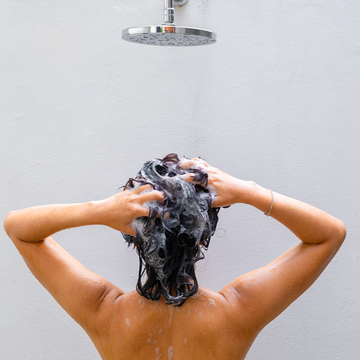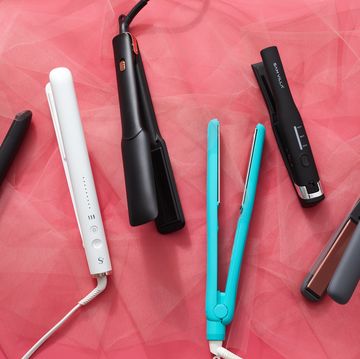Brittle and dry hair, for me, almost seem synonymous with the winter months and cold weather. I find that my naturally curly hair struggles to maintain its moisture and bounce almost as soon as the humidity leaves the air, which is why I was intrigued when I learned that hair steaming could improve my hair's ability to retain moisture.
“It’s a transformative process that infuses hydration deep into the hair’s cuticle layer using heat and moisture,” says Ebony Bomani, Pattern Beauty Hair Stylist & Brand Educator. She explains that the benefits of hair steaming include improved moisture retention, enhanced product absorption, reduction in breakage and split ends as well as curl definition.
The beauty of this service is that you can receive it at your local hair salon or enjoy the process from home with products like at-home steamers. I have never steamed my hair before at home, so I decided to get the experience from a professional at Ursula Stephen The Salon in Brooklyn, New York.
What is hair steaming?
“Hair steaming is a method that momentarily raises the hair cuticle, enabling better absorption of water and conditioning products into the hair shaft, improving the hair's flexibility and ease of styling, such as straightening hair or making curls more defined,” says Sabina Wizemann, director of the Good Housekeeping Institute Beauty, Health & Sustainability Lab. It can be thought of as “a spa day for your hair — indulgent, therapeutic and incredibly effective,” Bomani adds.
While the pros of hair steaming can contribute to overall hair health, Wizemann also warns that overexposure to steam can cause issues. “Contrary to the common misconception of the benefits of 'hydrated hair,' water and steam are not inherently advantageous for hair health.” She suggests getting treatments in moderation "as excessive exposure to steam and the resulting cyclical swelling and contracting of hair cuticles may lead to increased hair porosity and an elevated risk of breakage.” She also notes that “this is particularly relevant for chemically treated hair, where steaming may exacerbate existing damage and contribute to quicker color fade.”
Bomani recommends not exceeding 15 to 20 minutes in a single steaming session, but also notes that consistency is key in order to see results. “Steaming two to four times a month is usually enough to keep your hair hydrated without overwhelming it,” she says.
How much does hair steaming cost?
I paid $50 for the steam hydration treatment at Ursula Stephen The Salon, however you can also find similar treatments ranging anywhere from $30 to about $75, depending on the salon.
My hair steaming experience
The basis for a great steaming experience is built upon a clean canvas, according to Bomani. The service I received at the salon began with a thorough wash. My hair was cleansed twice with a shampoo, then my stylist applied a moisturizing mask to my strands.
She explained that the steaming session would help the mask to better penetrate my hair and help it to better maintain moisture. Next, she sat me under the steamer for 30 minutes.
The process was extremely comparable to sitting under a hooded dryer for a deep conditioning treatment, though instead of a shower cap being placed over my head to lock in the moisture, the steamer expelled warm steam directly onto my hair.
Following the 30 minutes, the stylist rinsed out the mask with cool water and patted my hair dry with a towel. I could immediately feel the difference in the softness of my hair and I also noticed that it did not have the typical brittle feel that I often experience even after conditioning in the winter.
The rest of my service was finished off with a blow dry, though I could have opted to have my natural curls styled.
Is hair steaming worth it?
I think that in order for my hair to thrive in the harsh winters in New York City, adding a monthly steaming to my hair care routine couldn't hurt. Following the hair steaming service, I did notice an immediate difference in the look and feel of moisture in my hair that I don't typically achieve on my own at home. I would also consider investing in a steamer for home so that I could get these same results even without making a trip to the salon, which could be more cost effective in the long run.
Can you steam your hair at home?
For a more economical approach, Bomani says you can steam your hair at home. "Steaming at home is also an excellent way to amp up your moisture regimen between professional treatments," she says. "Pattern has an elevated, highly effective steamer that's user-friendly and designed to provide a spa-like experience in the comfort of your own home." Other steamers, which can be hooded or handheld, retail for anywhere between $15 to $150, though if you are steaming consistently, purchasing your own may be worth it.
In order to effectively steam your hair at home, Bomani recommends starting with clean hair. "Steaming works best when the hair and scalp are clean, as there is no product buildup blocking the cuticle," Bomani says, adding that a gentle clarifying shampoo is best to help remove build-up and create the best base for effective steam treatments.
Next, you should coat your hair with a nourishing mask or hydrating treatment and steam for no longer than 20 minutes. "After steaming, rinse your hair with cool water to seal the cuticle and lock in moisture," Bomani says.
My final thoughts
My hair steaming experience was a great way to give my curls a little extra love. I think it did help to combat the dryness that I had been experiencing, and I did enjoy how soft my hair felt post service.
I also love that the process is simple enough that I could recreate it at home with my own hair masks or deep conditioners and my own steamer. However, I did feel that it was very similar to a deep conditioning treatment and the two produce nearly identical results. I would recommend this service if you are looking for an alternative to deep conditioning under a hot hooded dryer, as the steam wasn't uncomfortably hot as a hooded dryer can tend to be.















